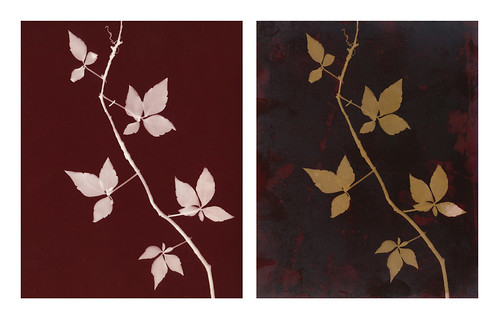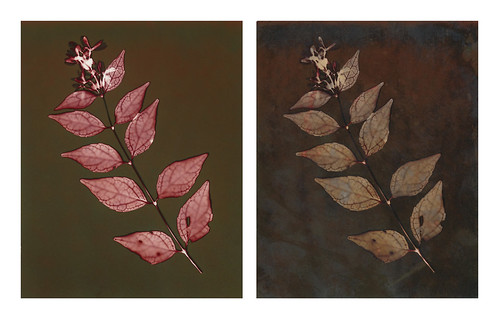Why is this even an issue? If you don't fix a silver gelatin print, the image is destroyed by light. Same thing, right? But no one argues against fixing silver gelatin prints. The different is that in the lumen process, fixing has a drastic and sometimes unpredictable effect on the appearance of the print. Fixing a silver gelatin image doesn't work that way. An un-fixed silver gelatin print looks exactly the same as a fixed one. Lumen prints can lose detail, bleach or even change their color palette completely during the fixing process. It's entirely possible to remove a print from the fixer that bears only a passing resemblance to what you put into the fixer minutes earlier. So by fixing a lumen print, you're not just ensuring that print can be displayed and maintained archivally, you're may be totally altering the appearance of the image.
 |
| Pre (left) and Post (right) fix versions of the same print |
I will say that the change is not always drastic. There are certain brands of paper that show only a slight to medium amount of fading in the colors after fixing. However, there are others that shift to an almost entirely new image. The only way to check what will happen to your specific print is... to fix it. And there's no going back, of course. No undo button, and no "cancel process" command. Unless you have a high-quality scan or photograph from before fixing, your lumen's original post-exposure appearance can be forever lost.
"It's Broke! Fix it!"
This may actually be the more common opinion. I haven't done any polls on the subject, but it comes up quite often in online guides for how to do lumen prints, and appears fairly often as questions ("Is this fixed?") in online communities for alternative processes. The reasoning behind this position is that your print isn't finished until it's fixed. Until a lumen has been fixed, just as with any silver gelatin print, it will continue to expose and degrade under light. Unfixed lumen prints aren't just non-archival, their lifespan is measured in hours.
 |
| Pre (left) and Post (right) fix versions of the same print |
So that's why they want to fix their lumen prints. Some online guides I've read basically say that lumen isn't finished until it's been fixed. The 'original' appearance that you see when you take the image out of the exposure frame isn't finished anymore than a cyanotype that hasn't gone into the water bath. It's basically a latent image that needs to be fixed before you can see what it "really" looks like.
"It Ain't Broke! Don't Fix It!"
And here's my side of the argument. Let me preface it by saying that I do not consider the end result of alternative processes to necessarily be a physical product. For me, alternative processes are another set of tools to create an image. That image, not any single piece of paper, cloth, skin or metal is the final product. As a result, I am far more concerned with keeping the integrity of the image, through whatever means necessary, than I am about keeping the integrity of the physical print. I don't care if my print turns black and crumbles into ash so long as I have high-quality photographs and scans of it recorded first. With those scans and photographs, I can make as many copies of my original image as I want. Photography, after all, is a reproductive medium. It's designed to make multiple copies of images. That's basically the whole point of photography.
 |
| Pre (left) and Post (right) fix versions of the same print |
In the "Fix It" camp section, I briefly mentioned latent cyanotypes. I should not that I also consider pre-development cyanotypes fair game for scanning and recording. Sometimes the bright green image on an undeveloped cyanotype can be particularly arresting. I don't see any reason to treat that image, however transitory, any differently from a lumen print. You can take this as further evidence of my craziness, if you disagree, or nod along sagely if you're in my camp.
So, Is It Broke?
It all comes down, really, to deciding what your desired end result is. An image? Or a product? If you want your image, then at whatever stage in the process your image looks like you want it to, stop there and use whatever means needed to record the image in a permanent fashion. If you want a product, follow whatever steps are needed to make your print as archival as possible and simply acknowledge that the earlier stages of the image will not be permanent.
I am really enjoying your blog, thank you for all the info and inspiration, I started in traditional b & w photography, but have moved on to playing with lumens, chemigrams, photograms etc, and I have struggled with what exactly is my final product,
ReplyDeletebecause it seemed "wrong" to offer a digital print from an alternative process, but after reading your thoughts here, I can't thank you enough for clarifying the issues for me, and I totally agree with you - alt processes are tools for image making and the artist gets to decide when that image is final and how it will be presented... Blessings, K
I was cleaning out my in-laws home and found stacks and rolls of photography paper. I wouldn't even have recognized it had I not signed up for an alternative printmaking class only a few weeks earlier. I have had to figure out the whole process by myself. I am comfortable with subject and composition, but I've had a difficult time figuring out how to fix. I definitely like the result pre-fixed, but I haven't really received any information on exactly what products to use to fix an how to actually fix a print. All info says to use according to directions, but I can't find specifics. I would appreciate any suggestions.
ReplyDelete